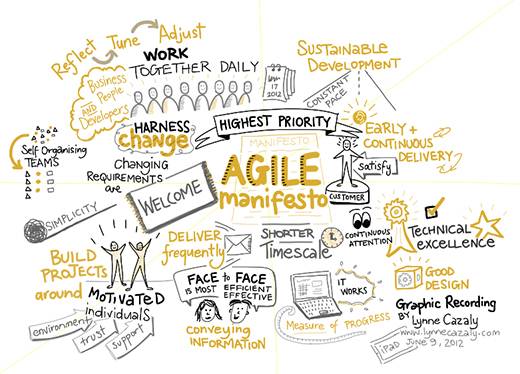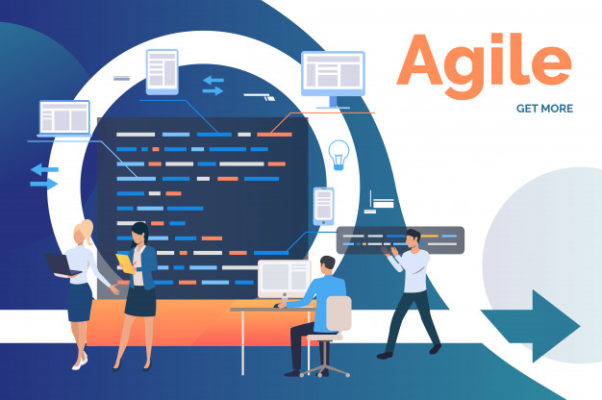Agile method and Scrum process aren’t the new trends but a part of IT companies.
So what Agile and Scrum are that Developers praise. This article will answer all.
What is Agile?
Agile is a flexible software development method to get products to the customers’ hands as quickly as possible.
Agile Manifesto

Manifesto for Agile Software Development, which is shortened as Agile Manifesto, gives the best values that most Agile theorists and practitioners have to follow. This is the full text of the Agile Manifesto:
Flexible software development manifesto
We had discovered how to develop better software by performance and helping others.
Thanks to it, we can highly evaluate:
Personalization and interaction are better than tools and processes;
The software runs better than full content;
Customer collaboration better than contract negotiation;
Respond to the changes rather than stick to the plans.
Even the right items are still valid, but we appreciate the things on the left.
The developers also emphasize twelve principles behind the Agile Manifesto to suggest developers practice and apply them in practice. Those are the following principles:
1-1. Our highest priority is customer satisfaction via early and continuous delivery of valuable software.
1-2. Change of requirements is welcome, even if it’s late in process development. Flexible processes take advantage of change for a customer’s competitive advantage.
1-3. Regularly deliver the best software to customers from several weeks to several months, and preference is given to shorter periods.
1-4. Traders and developers have to cooperate daily throughout a project,
1-5. Building projects motivates individuals, providing the environment and necessary support and believing them to complete the tasks.
1-6. The most effective method to communicate information to development teams and within the groups is direct conversation.
1-7. Good software is a crucial measure of progress.
1-8. The flexible process can promote sustainable development. Sponsors, developers, and users can maintain an unlimited continuous pace.
1-9. Continuous paying attention to good engines and design to increase flexibility.
1-10. The simplicity – the art of maximizing the unfinished tasks – is fundamental.
1-11. Self-organization teams will perform the best architecture, requirements, and design.
1-12. The production teams will continuously think about how to be more effective. Then they will adjust and change their behavior accordingly.
Features

Iterative
The project is implemented in repeating segments. Those segments (called Iteration or Sprint) are usually short timeframes (from 1 – 4 weeks).
In each segment, development teams perform all necessary works such as schedule, requirement analysis, design, testing, deployment (with different levels) to produce small parts of products.
Agile methods often decompose goals into small chunks with the most straightforward and most compact planning process possible and don’t do long-term planning.
Incremental and Evolutionary
At the end of the segment, development teams typically produce small portions of the final products.
These sub-pieces are usually sufficient, capable of running well, carefully tested, and immediately usable (called potentially shippable product increment of functionality).
Over time, segment after segment, these runners will accumulate and grow until all customer requirements are satisfied.
Adaptive
Since the segment lasts for a short time, and the schedule also frequently is adjusted, changes during development (change requirement, technological change, change on target, etc.) can be met suitably.
Therefore, the Agile process is mainly well suitable for changes.
Self-organizing and cross-functionality
An agile team structure usually is cross-functionality and self-organizing.
Those teams perform assignments without relying on the title or work’s hardware descriptions based on a clear hierarchy in the organization.
Self-organizing means the competency is complete, necessary for software development, so it’s empowered to make decisions independently, manage itself, and organize its work to achieve the highest efficiency.
Empirical Process Control
Agile teams can make decisions based on empirical data instead of prescriptions or theoretical calculations.
In other words, Agile shortens the short feedback life cycle to adjust and increase flexibility easily.
Over time, those strategies will get closer to the optimal status. Therefore the team can control the process and increase labor productivity.
Face-to-face communication
Agile encourages development teams to communicate with customers to understand more about what they truly need instead of depending on the writings regarding customers’ requirements.
Instead of a programmer (coding) and an engineer (designing), the development teams’ internal communication will communicate through a design.
Value-based development
One of Agile’s fundamental principles is that “Good software is a key measure of progress.” This principle eliminates redundant works that do not directly add value to the product.
To operate the “value-based work,” Agile teams often work directly and regularly with the customer (or customer representative). Work directly with them to determine which requirements have higher priority and deliver more value as soon as possible to the project.
So Agile projects usually help customers optimize project’s values. Almost directly, Agile dramatically increases customer satisfaction.